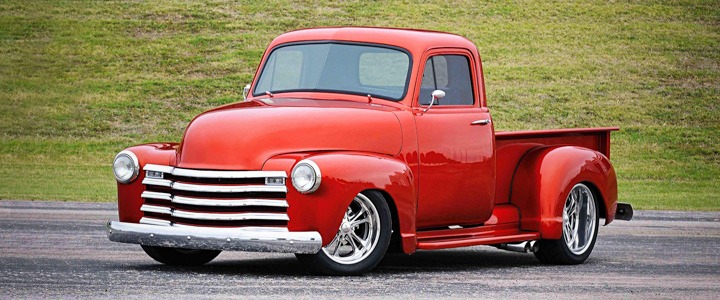
From 1947-1955, Chevrolet and GMC’s “Advance Design” era offered larger, stronger trucks with shared platforms but distinct styling. GMC models often featured more powerful engines. This period marked a significant post-WWII redesign, lasting until the 1955 Task Force series.
• Early trucks were titled on either the body ID plate or engine number. If the title used the engine number and it has been replaced, it can cause problems with vehicle registration or resale.
• Dark green was the standard exterior paint color prior to 1955. Most other colors, including black, were a non-cost option.
• From 1939 onwards, the GMC six-cylinder engine was a high-pressure insert bearing design, initially 228 and 248 cubic inches. This resulted in GMC dash clusters typically having a maximum oil pressure gauge reading of 60# or 80#, while the similar-appearing Chevrolet clusters (which did not fully adopt insert bearings until 1954) read 30#.
• The bed planks in GM step pickups have been hard yellow pine since the late 1930s, not oak. These planks were not varnished but were typically painted black on 1955 and earlier models, and body color or black after 1955 for better protection.
• A low-pressure version of the Chevrolet 235 six-cylinder engine was available on larger trucks between 1941 and 1953. This earlier 235 engine had little interchangeability with the later high-pressure version.
• Almost all Canadian-built GMC pickups prior to 1953 used the Chevrolet 216 engine instead of the 228 and 248 GMC engines found in U.S. trucks. The Canadian Chevrolet model using the larger GMC 228 and 248 engines was known as the “Maple Leaf.”
• GMC trucks began the transition to a 12-volt electrical system in 1953. GMC used a positive ground system with their 6-volt setups, while Chevrolet used a negative ground.
• Radios became available as an in-dash option with the introduction of the 1947 “Advance Design” body style.
• During 1947-48, the painted grille bars and “back splash” bars on Chevrolets were body color, with a horizontal stripe matching the cab stripe on the leading edge of each outer bar. On 1949-51 Chevrolet models with a painted grille, the “back splash” bar was white. This changed to light gray in 1952-53 to match the hubcaps and bumpers. On chrome grilles, only the outer bar was plated, with the “back splash” bar being the same as on painted grilles.
• Between 1947 and 1953 on light trucks, the cabs and fenders were painted the same color. Two-tone cabs were not available on this series until 1954, when a white top became an option on more deluxe cabs.
• The cabs were the same for both pickups and larger trucks in this era (1947-59), but the front fenders, hoods, and grilles were larger on the bigger trucks to accommodate their larger tires.
• On the 1947-55 series, the door panels were made of the same material as the seat upholstery, unlike the cardboard headliners.
• 1950 saw the introduction of modern tubular shock absorbers.
• 1951 marked the introduction of door vent windows.
• Shortages during the Korean War led to the elimination of brightwork on 1952 and 1953 trucks. Painted items included hubcaps, bumpers, grilles, radio speaker trim, glovebox doors, and interior window cranks and wiper knobs were changed to maroon plastic.
• Chevrolet’s famous high-pressure 235 six-cylinder engine was used between 1954 and 1962, with the larger 261 engine being a related design with some larger internal parts.
• 1954-55 models featured rounded taillamps, a cross-type bull nose grille, a one-piece curved windshield, a redesigned dashboard, and a deeper bed with flat-topped bed sides.
• Full wheel covers became available as an option in 1954.
• Chevrolet 1st series models in 1955 were the last to be offered with a 6-volt electrical system, as the company fully transitioned to 12-volt.
• Most ½-ton pickups prior to 1955 used 16-inch wheels. 15-inch and 14-inch wheels were not common.
• Whitewall tires were not available as a factory option before 1955.
• The GMC and Chevrolet pickups shared bodies, most suspension components, and transmissions, but differed in engines, grilles, tailgates, exterior colors, and hubcaps.
• Right taillights were an option until the late 1950s.
• From at least 1955 and earlier, the raised lettering on the tailgates was the same color as the tailgate itself.